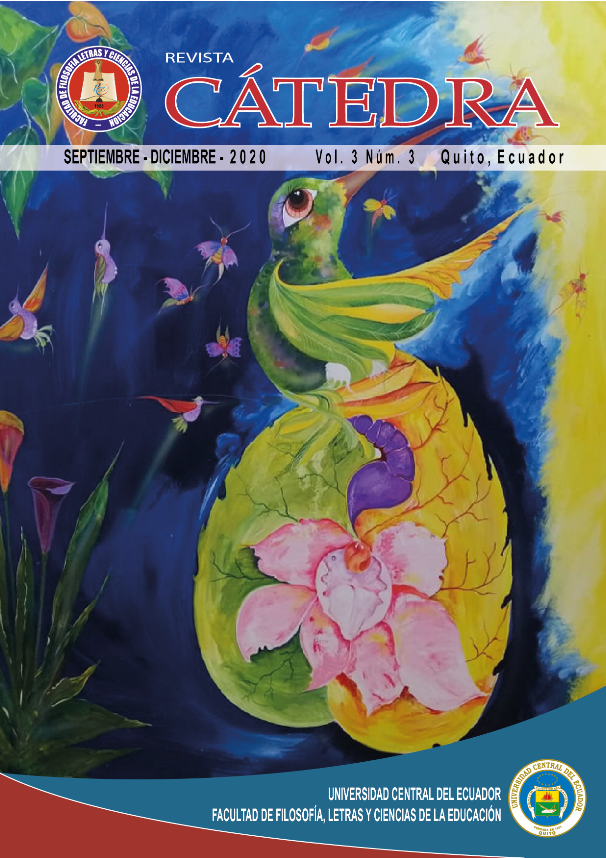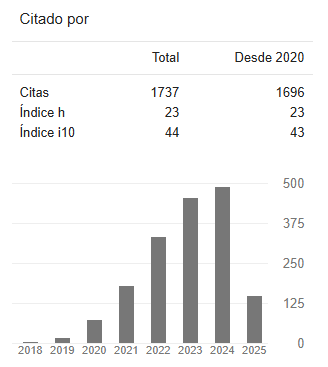Estudio lingüístico sobre las dimensiones contextuales de la caricatura política
DOI:
https://doi.org/10.29166/catedra.v3i3.2202Palabras clave:
Caricatura política, contexto, pragmática, retórica, teoría de la relevanciaResumen
La caricatura constituye uno de los géneros periodísticos de opinión de gran auge en las últimas décadas, en ella se conjugan multimodalmente la ironía, el humor y la sátira para analizar los hechos relevantes de un país. El análisis del discurso permite establecer una relación conjunta entre la realidad social y la cognitiva en este tipo de texto. Esta investigación se propone analizar, desde el enfoque pragmático, el discurso de la caricatura política de Eduardo Sanabria sobre la contienda electoral de 2017 en Venezuela bajo un enfoque cualitativo y diseño descriptivo-exploratorio. El análisis del discurso es la técnica empleada. El corpus estuvo conformado por cinco caricaturas publicadas en el diario El Nacional días previos a los comicios y cuyo tópico central se circunscribe a la convocatoria electoral. El análisis identificó los contextos: icónico – lingüístico, situacional y sociocultural. Los actos de habla y las figuras retóricas se identificaron como estrategias discursivas dirigidas a evidenciar la intencionalidad de una comunicación ostensiva como es la caricatura. Se tomaron los aportes de la Teoría de la Relevancia (Sperber y Wilson, 2004) y de la Teoría de los actos de habla (Austin, 2016; Searle, 2017). Se evidencia un macroacto de habla ilocutivo como es la convocatoria a votar. Se concluye que el discurso de las caricaturas de Sanabria expresa la crítica sobre el evento electoral a partir del juego de lo implícito, construido discursivamente entre lo icónico – lingüístico, el componente retórico y el contexto, estableciéndose una relación de complicidad con el lector.
Descargas
Citas
Agelvis, V. (2010). Zapata y la caricatura. Anuario Grhial, 4 (4), 43-62. De http://www.saber.ula.ve/handle/123456789/32815
Austin, J (2016) Cómo hacer cosas con palabras. España: Paidós Ibérica.
Bracho, Ángel (2018). Tratamiento sobre política y economía en la prensa nacional tras el 15 octubre de 2017. Análisis de contenido. Telos, 20 (3), http://www.redalyc.org/articulo.oa?id=993570020010
Bonilla-Castro, E. y Rodríguez Sehk, P. (2005). Más allá de los dilemas de los métodos. La investigación en Ciencias Sociales. Grupo editoral Norma: Bogotá-Colombia.
Calsamiglia, H. y Tusón, A. (1999). Las cosas del Decir. Barcelona: Editorial Ariel Lingüística.
Chirinos, A, Franco, A y León, F (2010). Análisis semio-lingüístico de las caricaturas de Pedro León Zapata. Revista de Artes y Humanidades Única, 1 (1), 15-43.
Escandell, M.V. (2014). La comunicación. Lengua, cognición y sociedad. Madrid: Akal.
Hernández, R., Fernández, C., y Baptista, P. (2014). Metodología de la investigación. México: Mc. Graw Hill.
Morales, E. & Samper, J. (2017). Abordaje discursivo de una caricatura política. Amauta, 15(39), 71-83. http://doi.org/10.15648/am.30.2017.6
Prada, J; Ramirez, J y Pinzón, D (2018). Articulación de la caricatura política como fuente para la investigación social en Colombia: estado del arte y perspectivas a comienzos del siglo XXI. Reflexión Política, vol. 20, núm. 40. https://dialnet.unirioja.es/servlet/articulo?codigo=6837419
Reyes, G. (2007). El abecé de la Pragmática. Arco Libros
Sanabria, E. (13 de octubre de 2017). Vota. Multiplica la señal. El Nacional. Recuperado de https://www.instagram.com/p/BaMM0RqAbL4/
Sanabria, E. (12 de octubre de 2017). Mi novio no va a votar ¿y entonces? Lo voy a votar. El Nacional. Recuperado de https://www.instagram.com/p/BaJoVryAxgW/
Sanabria, E. (11 de octubre de 2017). Salgan todos a votar. No queremos “Abstemios”claro que si… . El Nacional. Recuperado de https://www.instagram.com/p/BaHGJjQAbKe/
Sanabria, E. (9 de octubre de 2017). Que el voto esté contigo. El Nacional. Recuperado de https://www.instagram.com/p/BaCMU4XAw-h/
Sanabria, E. (8 de octubre de 2017). Revise su “circuncisión” y vaya a votar. Si señor… El Nacional. Recuperado de https://www.instagram.com/p/BaCMU4XAw-h/
Searle, J. (2017). Actos de habla: Madrid: Cátedra.
Searle, J. (1994). Actos del habla: Ensayo de filosofía del lenguaje. Planeta-Agostini: Barcelona.
Sperber, D. y Wilson, D. (2004). Teoría de la Relevancia. Revista de Investigación Lingüística, 7, 233-283. De http://revistas.um.es/ril/article/view/6691
Van Dijk, T. (1999). Ideología, una aproximación multidisciplinaria. Gedisa: Barcelona.
Van Dijk, T. (2016). Estudios críticos del Discurso: un enfoque sociocognitivo. En Discurso y sociedad. Vol.10 (1) pp. 137 – 162
Descargas
Archivos adicionales
Publicado
Versiones
- 2021-01-07 (4)
- 2020-11-12 (3)
- 2020-11-12 (2)
- 2020-09-29 (1)









